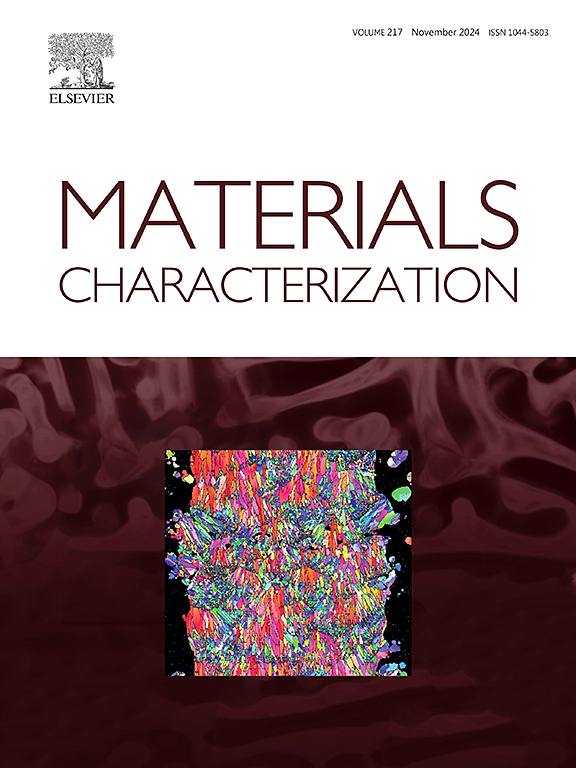Heterogeneous plastic deformation and crack passivation behaviors influenced by phase morphology in Mg-Li alloys
IF 4.8
2区 材料科学
Q1 MATERIALS SCIENCE, CHARACTERIZATION & TESTING
引用次数: 0
Abstract
Magnesium-lithium (Mg-Li) alloys, known for their high specific strength, are highly attractive for lightweight structural applications. For dual-phase Mg-Li alloy, the small adjustment of Li content will result in a huge difference in the mechanical properties and microstructures. In this study, the effects of lithium (Li) addition on grain refinement and deformation mechanism were investigated in dual-phase Mg-Li alloys. In situ tensile testing combined with digital image correlation (DIC) analysis reveals that refinement of α-phase grains enhances plastic deformation and reduces strain localization. The α1 phases in Mg-8Li alloys, with an average width of 52.8 μm, are more susceptible to yielding than the α2 and α3 phases, which have average widths of 1.34 μm and 0.66 μm, respectively. In contrast, Mg-9Li avoids coarse α1 phases, resulting in delayed yield. Additionally, cracks in β phases of Mg-9Li alloys are consistently obstructed by the α2 and α3 phases, enhancing toughness by preventing direct shear fractures. Substantial α-phase grain refinement dissipates stress concentrations at crack tips, promoting crack tip passivation and a shift to fully ductile fracture behavior. The insights gained from these results will improve our understanding of the deformation behavior and guide the development of toughened dual-phase heterostructured Mg-based alloys.
相形貌对Mg-Li合金非均匀塑性变形和裂纹钝化行为的影响
镁锂(Mg-Li)合金以其高比强度而闻名,在轻量化结构应用中具有很高的吸引力。对于双相Mg-Li合金,Li含量的微小调整会导致力学性能和显微组织的巨大差异。在本研究中,研究了添加锂对Mg-Li双相合金晶粒细化的影响及变形机理。原位拉伸试验结合数字图像相关(DIC)分析表明,α相晶粒的细化增强了塑性变形,降低了应变局部化。Mg-8Li合金中平均宽度为52.8 μm的α1相比平均宽度分别为1.34 μm和0.66 μm的α2和α3相更容易屈服。相反,Mg-9Li避免了粗α1相,导致屈服延迟。此外,α2和α3相持续阻断Mg-9Li合金β相裂纹,通过防止直接剪切断裂提高韧性。大量α相晶粒细化消散了裂纹尖端的应力集中,促进了裂纹尖端的钝化,并向完全韧性断裂行为转变。从这些结果中获得的见解将提高我们对变形行为的理解,并指导增韧双相异质结构mg基合金的发展。
本文章由计算机程序翻译,如有差异,请以英文原文为准。
求助全文
约1分钟内获得全文
求助全文
来源期刊

Materials Characterization
工程技术-材料科学:表征与测试
CiteScore
7.60
自引率
8.50%
发文量
746
审稿时长
36 days
期刊介绍:
Materials Characterization features original articles and state-of-the-art reviews on theoretical and practical aspects of the structure and behaviour of materials.
The Journal focuses on all characterization techniques, including all forms of microscopy (light, electron, acoustic, etc.,) and analysis (especially microanalysis and surface analytical techniques). Developments in both this wide range of techniques and their application to the quantification of the microstructure of materials are essential facets of the Journal.
The Journal provides the Materials Scientist/Engineer with up-to-date information on many types of materials with an underlying theme of explaining the behavior of materials using novel approaches. Materials covered by the journal include:
Metals & Alloys
Ceramics
Nanomaterials
Biomedical materials
Optical materials
Composites
Natural Materials.
 求助内容:
求助内容: 应助结果提醒方式:
应助结果提醒方式:


